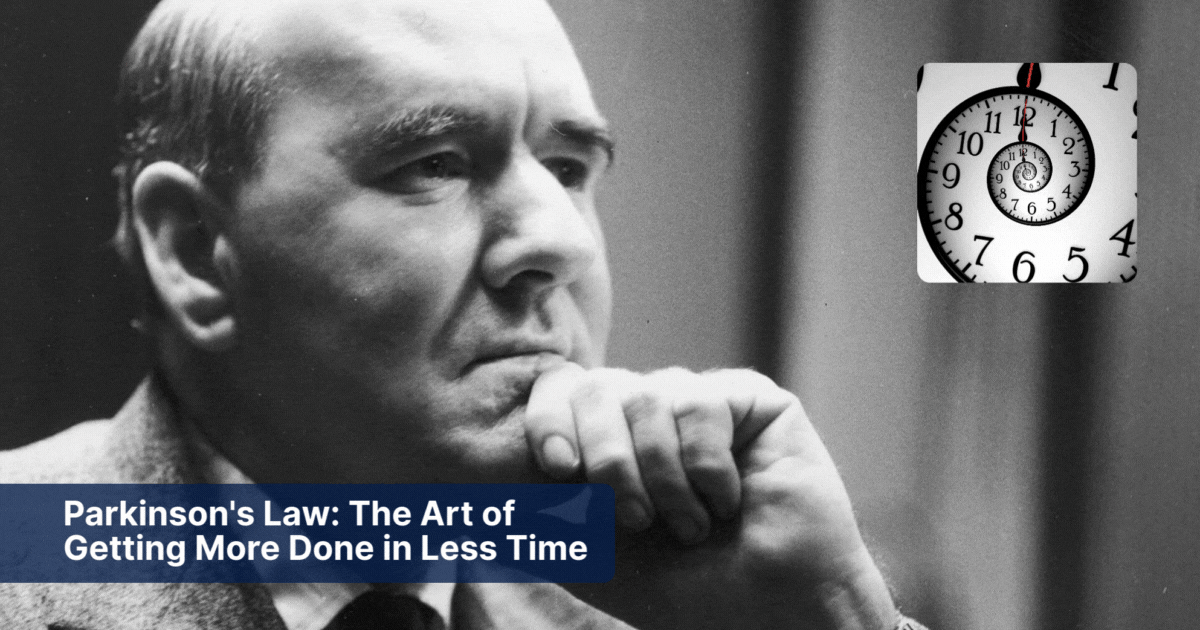Parkinson’s Law
Parkinson’s Law says work will stretch to fill the time you give it. Cyril Parkinson noticed this in the British Civil Service. As offices got larger and deadlines looser, the work didn’t get better — it just took longer. Even routine tasks grew complicated, as if the extra time had to be justified. But with a short deadline, the same people cut out the nonessential and got it done.
You’ve probably seen it in your own day. Give yourself all week for something, and it somehow takes all week. Tighten the window, and you focus on what matters. The fix is simple — though not always easy — set deadlines for yourself that are shorter than the official ones.
Here’s a summary of the “1975: Nationwide: Parkinson’s Law” video transcript in 7 bullet points with timestamps:
- (00:03) Introduction of Professor Sirill Northcut Parkinson—famously known for “Parkinson’s Law” (“Work expands so as to fill the time available for its completion”).
- (00:29) Parkinson’s Law is clarified as a critique of bureaucracy, not personally targeting his gardener.
- (01:01) Illustration: A civil servant seeking promotion hires six staff, yet actual workload remains the same—these staff then invent work to occupy themselves.
- (01:24) Another example: A single incoming letter keeps multiple officials busy; it loops through various handlers but ends up with essentially the same reply the original person would have drafted.
- (01:47) The message underscores how bureaucracies waste time through overprocessing and unnecessary layers of handling.
- (02:13) Parkinson shares a humorous anecdote: he’s asked to complete a detailed form, including details of deceased parents, which he fills in literally (parents deceased with “Elysian Fields” as address), illustrating bureaucracy's absurdity.
- (02:51) He signs off humorously, closing the bracket in the form—though trivial, the exchange highlights bureaucratic compliance gone awry.
The Seventy Percent Rule
Start when you’re about seventy percent sure you can succeed, not when you feel fully ready — because that day never comes. If you can run two miles and want to do a marathon, start with the two. Build the rest as you go.
The 70 Percent Rule for Beating Procrastination
The 70 Percent Rule says you don’t need to wait until you’re 100% ready before starting something. You start when you’re about 70% there. That’s enough to move forward, even if you still have gaps. The rest you figure out as you go.
In business, waiting until you’re 100% ready can mean you’re already behind. The 70 Percent Rule says you start when you’re roughly 70% prepared. That’s enough to make informed moves without wasting time chasing the last 30% of certainty. The rest? You work out as you go.
We all know how it happens. A strategy document sits in “review” for weeks. A budget proposal never leaves draft form because one number’s still being validated. A client pitch keeps getting pushed because the team’s “not quite ready.” By the time it’s done, the opportunity’s cold.
When you move at 70%, a few important things happen:
1. You weaken perfectionism’s grip
Perfectionism in business can be expensive. A deal window can close while you’re fine-tuning slides. A 70% threshold forces movement when conditions are good enough to act.
2. You gain momentum in the market
Markets shift. Competitors act. Even internally, priorities change. Launching a project, product, or financial model at 70% lets you build traction before conditions move on.
3. You get better data, faster
Planning in isolation is theory. Action brings real numbers. A preliminary investment analysis in the market will surface risks faster than a perfect spreadsheet locked on your desktop.
How to Apply It in Corporate Work
- Evaluate readiness – Look at what you’ve got: the research, data, approvals. If 70% is in place, that’s your green light.
- Pilot before perfect – Roll out a limited launch or soft test. Use the results to refine.
- Push decisions forward – If your investment committee has enough material for discussion, schedule the meeting. Waiting for the “final” version often kills momentum.
- Let the market teach you – Release the proposal, send the RFP response, publish the white paper. Feedback will show you what matters.
Examples in Business and Finance
- Corporate Strategy: You’ve built a market entry plan for a new region. The demand analysis is complete, but competitor profiles aren’t fully mapped. Move forward with a pilot launch—competitor intel will sharpen as you operate.
- Budget Planning: The forecast covers most departments, but a couple of cost centers still have estimates. Present it to leadership now so they can make strategic calls earlier.
- Investor Relations: Your quarterly results are mostly confirmed, except for one late vendor invoice. Issue guidance with the numbers you have—markets value timely updates over perfect figures.
- M&A Activity: Due diligence reveals no major risks, but a few operational questions remain. Lock in the letter of intent before another bidder steps in.
In business, timing often beats perfection. The 70 Percent Rule isn’t about being careless—it’s about recognizing when the extra polish adds little value compared to the cost of delay.
So before holding another review meeting or rewriting that deck, ask: Do we have 70%? If yes, the clock’s already ticking.
Procrastinating Matrix
We can implement the 70% rule here to get started. Remember, if it is not important, then delegate it to others or services, and if that is even too much for you, then trash the idea altogether.
The matrix
| Short Deadline | Long Deadline | |
|---|---|---|
| Start at 70% | High productivity, fast learning: You start early in skill development, use tight timeframes, and adapt as you go. Example: Sign up for a 5K race in 3 weeks when you can only run 2 miles. | Slow but steady: You begin with less than full readiness but have lots of time. Progress happens, but risk of losing urgency. Example: Writing a novel over 2 years starting with just an outline. |
| Wait for 100% | Stress-heavy perfectionism: You prepare fully before starting but face short timelines. Quality may drop because time is gone before you act. Example: Studying for weeks for a presentation due in 2 days and still feeling unready. | Classic procrastination: Long deadlines + waiting until you feel “ready” means you may never start. Example: Delaying a business launch for years to “perfect” the plan. |
Procrastinating sentences
Oh, maybe you think you don't do this? You don't procrastinate?
The truth we all know is that we do procrastinate way too much, and that is natural but I don't think that it is good practice to focus on everything in life through this lens as it would make life dawnting and unpleasant, so we need to focus on what is important and then apply the method to remove the procrastination!
Have a look below at some of the ways we procrastinate!
Practice sentences
| What You Say | What It Really Means |
|---|---|
| “I’ll get started after lunch… I work better later in the day anyway.” | I’m stretching this task to fit the time I’ve decided to waste first. |
| “It’s not due for another two weeks, so there’s no rush.” | I’ll delay starting so the work naturally fills the entire two weeks. |
| “I’ll wait until I can block off a whole day for this.” | I’m avoiding starting now, even though I could make progress in smaller chunks. |
| “I still have plenty of time — I’ll start once I’m in the right mood.” | I’m letting time pass so the deadline forces my focus later. |
| “I’ll begin once I’ve done a bit more research.” | I’m overcomplicating it so I can justify not doing the actual work yet. |
| “I just need to finish organizing my notes before I can start.” | I’m adding extra steps so the prep phase takes as long as possible. |
| “There’s no point starting now, I’ll lose my flow when I have to stop for dinner.” | I’m waiting for a perfect block of time that doesn’t exist. |
| “I’ll start when the deadline feels closer — that’s when I really focus.” | I rely on pressure to work, so I’ll delay until I feel it. |
| “I’ll make a detailed plan first so I don’t waste time later.” | I’m spending more time planning than doing to fill the available time. |
| “I’ll wait until Monday, it makes sense to start fresh at the beginning of the week.” | I’m finding a calendar-based excuse to postpone action. |
| “I’ll get to it after I finish these smaller, easier tasks.” | I’m choosing less important work so the main task has to fit into whatever time is left. |
| “It’s a big project, so I’ll need at least a month to even start thinking about it.” | I’m giving it a large time frame so it can expand to fill it. |
Proactive (Non-Procrastinating) Sentences
Do you really want change, or are you procrastinating on that, too?
Below are examples of sentences transformed from a procrastination mindset into a proactive, forward-moving one. Read them, get the feel, and apply the same shift to anything you do.
My personal favorite is, “I can get a lot done in 5 minutes.” I love that one — I use it all the time.
Non-Procrastinating sentences
| Procrastinating Sentence | Proactive Reframe |
|---|---|
| “I’ll get started after lunch… I work better later in the day anyway.” | “I’ll start now and see how far I can get before lunch.” |
| “It’s not due for another two weeks, so there’s no rush.” | “I’ll complete the first draft by tomorrow so I can refine it later.” |
| “I’ll wait until I can block off a whole day for this.” | “I’ll use the next 30 minutes to make real progress.” |
| “I still have plenty of time — I’ll start once I’m in the right mood.” | “I’ll begin now and let my focus improve as I work.” |
| “I’ll begin once I’ve done a bit more research.” | “I’ve researched enough to start — I’ll gather the rest as I go.” |
| “I just need to finish organizing my notes before I can start.” | “My notes are good enough — I’ll start building the draft today.” |
| “I’ll start when the deadline feels closer — that’s when I focus.” | “I’ll set my own early target so I can work without panic.” |
| “I’ll make a detailed plan first so I don’t waste time later.” | “I’ll make a quick plan and begin within the hour.” |
| “I’ll get to it after I finish these smaller tasks.” | “I’ll do the main task first while my energy is high.” |
| “It’s a big project, so I’ll need at least a month to think about it.” | “I’ll break it into steps and start the first one right now.” |
Closing up
I hope this was helpful for you. Before you take things too seriously, remember — we use methods and techniques to work around what doesn’t come naturally. Being hard on yourself about these things isn’t healthy. Use the tools, apply the techniques, and with time, things come together.
Clarke




Comments